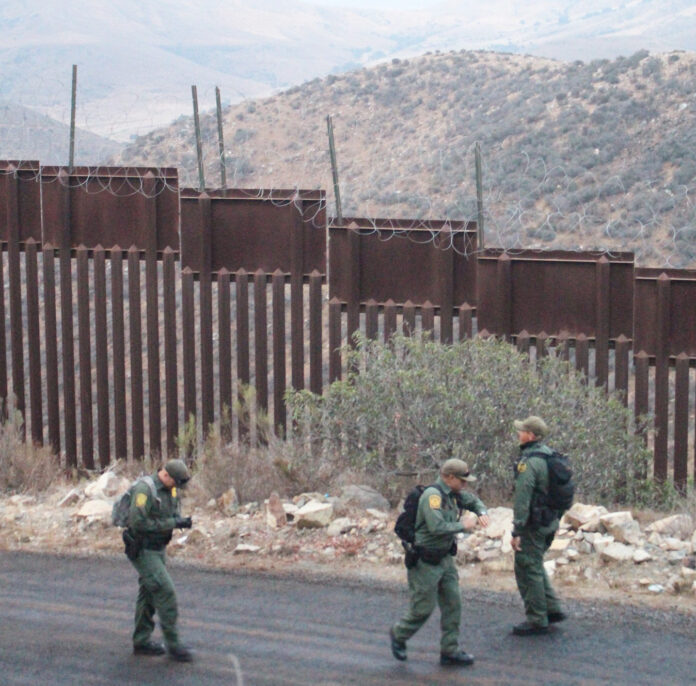The bumpy, dirt road that leads to Otay mountain on the American side of the U.S.-Mexico border ends at a section of rusted fence wall topped with barbed-wire. The iron structure stands about four times taller than a nearby waist-high post; a plaque attached to the gracefully shaped post reads “Boundary of the United States Treaty of 1886.”
A Border Patrol agent takes a headcount of journalists being led on unmarked paths migrants make when they enter the United States.
Sections of wall have been strategically built as a deterrent in areas where it is slightly easier to traverse the unforgiving terrain, however the border itself is a meandering line that has little to no demarcation beyond a sudden increase in elevation.
 “The trees down there,” Border Patrol Agent Jeff Stephenson says, “that’s how we identify the border. There’s a fence for cattle but that’s it”.
“The trees down there,” Border Patrol Agent Jeff Stephenson says, “that’s how we identify the border. There’s a fence for cattle but that’s it”.
Besides Marron Valley road and the Truck Trail, there is almost no way to enter or exit the area except on foot and even those roadways are just wide enough for one vehicle to utilize at a time; they enable agents to cut across several miles of thick vegetation and access the first peaks of the mountainous area just a little faster.
There are two helicopter landing pads on the mountain, and a rescue hoist is also an option in areas where landing is impossible but the great majority of the area is only accessible on foot.
Ironically, Stephenson said, groups are often dropped off the side of a paved Mexican highway along with smugglers, only to find themselves navigating scrubby trails on the American side of the border that are easy to lose. About seven to eight miles from where they’re dropped off, “a trek in and of itself,” the truly grueling part of scaling the mountainous terrain begins.
Modern Hiker website describes the “expansive views” one can enjoy from the 2600-foot elevation. Border Patrol agents, however, are constantly looking for undocumented immigrants who are frequently picked up in distress, some requiring extensive rescue efforts while most simply need hydration before being transported back to Mexico.
 Stephenson and fellow agent Jacob MacIsaac attempt to describe the severity of the hike, with steep inclines, low desert vegetation designed by nature as a deterrent which provides no shade, weather that ranges from punishing summer temperatures to winter hail. However, there is no description that can compare to scaling the mountain itself. Even on an overcast day, it is an arduous experience for someone with adequate water, proper footwear, and the overarching awareness that there is an end in sight.
Stephenson and fellow agent Jacob MacIsaac attempt to describe the severity of the hike, with steep inclines, low desert vegetation designed by nature as a deterrent which provides no shade, weather that ranges from punishing summer temperatures to winter hail. However, there is no description that can compare to scaling the mountain itself. Even on an overcast day, it is an arduous experience for someone with adequate water, proper footwear, and the overarching awareness that there is an end in sight.
Nightfall holds a different set of challenges: the desert heat lifts but there is increased risk for getting turned around and lost. Border Patrol agents have military-grade electronic maps that reveal their individual locations in reference to distinguishing features like a “saddle” on the mountain; smugglers and the groups they bring through the area move almost entirely based on natural features of the land.
The network of spider trails vary from clearly traveled to nearly indistinguishable, even to the agents who are familiar with the lay of the land. Sometimes, Stephenson says, they have to take a step back and let the paths reveal themselves— a swath of disrupted brush might subtly indicate where a new path picks up.
A few years back, Stephenson said, agents began to recognize a particular set of bootprints that had an unusual pattern; their repeated presence indicated the wearer was a frequent smuggler but that fact, while helpful in tracking a criminal, is meaningless in a court of law.
If he could inform the public of one thing, he said, it would be that he is there to preserve life above all else.
The groups that cross the mountain are doing so as the final leg of a journey that might have already proven traumatic. Often, Stephenson says, they are at the mercy of the smugglers who bring them in groups for a cash payout or servitude in some capacity. They are typically unprepared for their first entry to the United States and agents frequently encounter dead or dying individuals.
“I’ve had to carry little kids out of here. People often die alone, left behind to catch up or abandoned entirely,” Stephenson said.
The evidence of life and death is scattered across the mountain. Bone-dry water bottles and rusted cans litter the ground at each peak, occasionally punctuated by items discarded by someone who might have lived long enough to make it to safety: blue jeans, caps, shoes, a wad of used toilet paper and, inexplicably, a mask to protect against COVID all stand out against the sandy ground.
“What makes me the most angry is that smugglers don’t care. They don’t care about the risk, they don’t care about people, they are acting completely for profit and they really don’t care if they leave someone for dead,” Agent Shane Crottie said.
Stephenson said, most agents are grateful for the current administration’s emphasis on building infrastructure. Older networks of basic trail sensors have been in place for years, he said, but infrastructure funding means they can install newer systems like autonomous detection towers, essentially a rapid fire camera powered by Artificial Intelligence that can detect whether there is a person moving around the area, or another animal.














